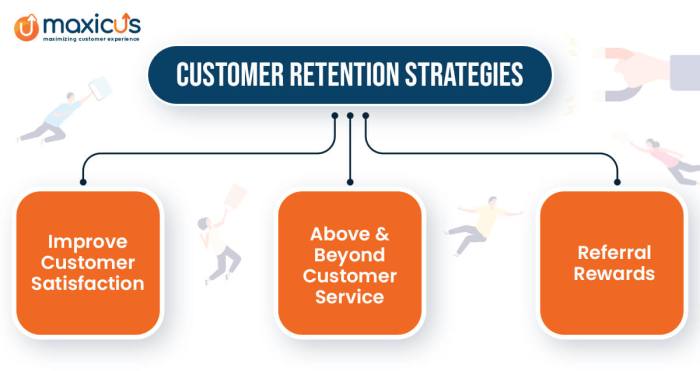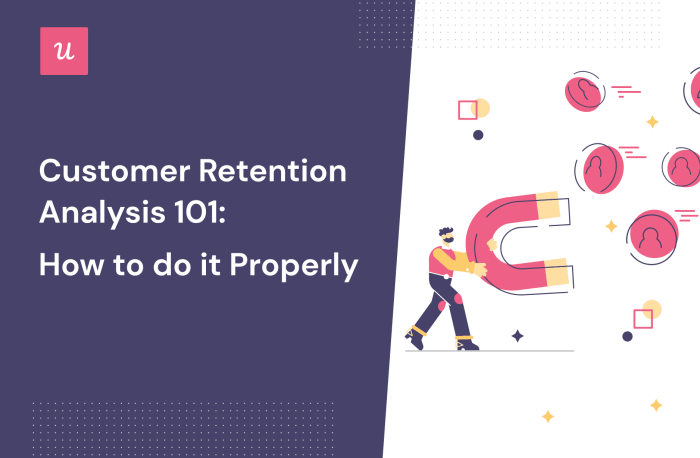Understanding Customer Retention sets the stage for unraveling the secrets behind retaining loyal customers and maximizing business success. Dive into the world of customer loyalty and long-term profitability with us.
In this guide, we’ll explore the importance of customer retention, strategies for enhancing it, understanding customer behavior, and the art of building customer loyalty.
Importance of Customer Retention: Understanding Customer Retention

Customer retention is crucial for businesses as it focuses on keeping existing customers engaged and satisfied, leading to increased loyalty and repeat purchases. By retaining customers, businesses can benefit from higher profitability, improved brand reputation, and long-term success.
Impact on Profitability
Customer retention directly impacts profitability by reducing the cost of acquiring new customers. It is more cost-effective to retain existing customers than to attract new ones, as loyal customers tend to spend more and make repeat purchases over time. Additionally, satisfied customers are more likely to recommend the business to others, leading to new customers through word-of-mouth referrals.
Long-Term Benefits, Understanding Customer Retention
Focusing on customer retention can result in long-term benefits such as increased customer lifetime value. Loyal customers are more likely to engage with the business consistently, providing a steady revenue stream. Furthermore, loyal customers are less sensitive to price changes and are more forgiving of occasional mistakes, leading to a more stable customer base. By prioritizing customer retention, businesses can build strong relationships with their customers, fostering trust and loyalty for years to come.
Strategies for Improving Customer Retention
When it comes to enhancing customer retention, businesses can implement a variety of strategies to keep their customers coming back for more. By focusing on building strong relationships and providing exceptional customer service, companies can create loyalty and increase customer retention rates.
Proactive vs. Reactive Approaches
- Proactive Approach:
- Proactively engaging with customers through personalized communication and offers.
- Anticipating customer needs and addressing them before they become problems.
- Implementing loyalty programs and incentives to reward repeat business.
- Reactive Approach:
- Addressing customer issues and complaints promptly and effectively.
- Offering solutions and compensations to dissatisfied customers to win back their trust.
- Using feedback and complaints as opportunities to improve products and services.
Real-Life Success Stories
Amazon
is a prime example of a company that excels in customer retention. By offering fast shipping, easy returns, and personalized recommendations, Amazon keeps customers loyal and coming back for more. Their proactive approach to customer service and continuous innovation have helped them maintain high retention rates.
Starbucks
is another success story in customer retention. Through their loyalty program and mobile app, Starbucks rewards frequent customers with free drinks and discounts, encouraging repeat visits. The company’s focus on creating a personalized and convenient experience has led to strong customer loyalty and retention.
Overall, by combining proactive and reactive approaches, along with personalized experiences and incentives, businesses can effectively improve customer retention and foster long-term relationships with their customers.
Understanding Customer Behavior
Understanding customer behavior plays a crucial role in improving customer retention. By analyzing how customers interact with your products or services, businesses can tailor their strategies to meet their needs and expectations, ultimately increasing customer loyalty.
The Use of Data Analytics
Data analytics can provide valuable insights into customer preferences, behavior patterns, and purchasing habits. By collecting and analyzing data from various sources, businesses can better understand what drives their customers’ decisions and tailor their offerings accordingly.
- Utilize customer data to identify trends and patterns that can help predict future behavior.
- Segment customers based on their preferences and behavior to create targeted marketing campaigns.
- Track customer interactions across different touchpoints to gain a holistic view of their journey.
The Role of Personalized Marketing
Personalized marketing involves delivering customized messages and offers to customers based on their preferences and past interactions with the brand. This approach can significantly impact customer retention by creating a more engaging and relevant experience for each individual.
- Use customer data to create personalized recommendations and promotions that resonate with their interests.
- Implement personalized communication strategies to build stronger relationships with customers.
- Offer exclusive deals or rewards to loyal customers to show appreciation for their continued support.
Building Customer Loyalty

Building customer loyalty is crucial for businesses looking to establish long-term relationships with their customers. Loyalty goes beyond retention, as it involves creating a strong emotional connection and trust with customers, leading to repeat purchases and advocacy.
Difference between Customer Retention and Customer Loyalty
Customer retention focuses on keeping customers coming back for more, while customer loyalty delves deeper into building a strong bond with customers. Loyalty is about creating an emotional connection that goes beyond transactions, leading to customers actively choosing a brand over its competitors.
Tips for Building Strong Relationships with Customers
- Provide excellent customer service: Respond promptly to inquiries and resolve issues effectively.
- Personalize the customer experience: Tailor your interactions and offerings to meet individual customer needs.
- Communicate regularly: Keep customers informed about new products, promotions, and updates.
- Reward loyalty: Offer exclusive discounts, rewards, and perks to loyal customers.
- Solicit feedback: Listen to customer suggestions and make improvements based on their input.
Examples of Loyalty Programs
| Loyalty Program | Success Metrics |
|---|---|
| Frequent Flyer Programs (e.g., Delta SkyMiles) | Increased customer retention, higher customer lifetime value, and advocacy through referrals. |
| Starbucks Rewards | Increased frequency of visits, higher spend per visit, and a large and engaged member base. |
| Amazon Prime | Increased customer retention, higher order frequency, and enhanced customer loyalty through exclusive benefits. |
